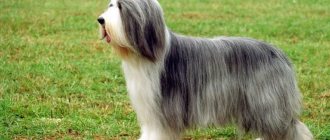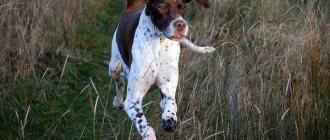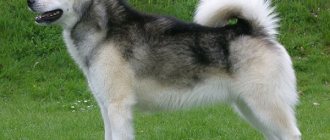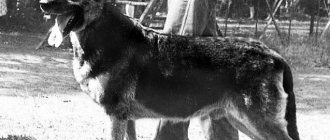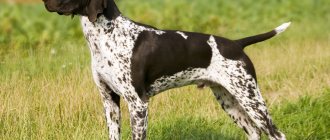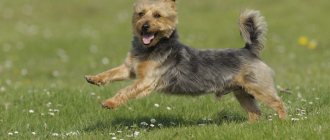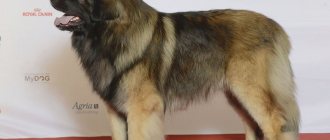Standard
The Spaniard has a clearly defined and unusual exterior. It has the following features:
- strong muzzle, flat skull structure,
- brown eyes,
- nose to match the main color ,
- hanging ears in the shape of a triangle,
- powerful shortened neck,
- wide chest,
- developed muscles,
- flat back.
The tail can be stubby or docked - at your discretion. The body is supported on strong paws, and their pads look like a cat's feet. At an early age, the fur is curly, and in adults it is twisted into peculiar cords. Available in white, black or brown. Boys grow up to 50 cm, and girls - up to 45 cm. The weight of males is 20 kg, and females - 16 kg.
Appearance
The head is massive. The skull is flat. The transition from forehead to muzzle is pronounced.
The eyes are slightly slanted. Color - from nut to brown.
The ears are hanging, triangular in shape. Neck. The neck is short, muscular, without dewlap.
The withers are not prominent. The croup is slightly sloping. The belly is somewhat tucked in.
The limbs are bony and strong. Cat's paws, arched.
The tail is docked at the level of the 2nd - 3rd vertebrae. Sometimes puppies are born bob-tailed.
The wool is always curly, like a fleece. When young, the coat is short, wavy or curly. In adult dogs, the hair begins to curl into cords.
Description of the breed
This is a wonderful companion for all family members without exception. The affectionate and benevolent animal is always calm and displays of aggression are alien to it. He is loyal to strangers if he does not see them as a real threat, but at the same time keeps them in sight, remaining wary.
The merman gets along well with children and is a convenient companion for noisy fun and active pastime. But leaving him alone with the child is undesirable. Because of its mobility, the dog can accidentally hurt or knock you down.
Constantly needs human presence. Solitude is difficult to bear. Boredom pushes into petty pranks, which does not particularly please the owners. But he freely gets along with the rest of his smaller brothers, without dividing the territory.
It has pronounced herding and hunting qualities. At the same time, it requires daily physical activity. This is not a favorite for busy people. If you don't pay attention to it, you will suffer yourself. Then you will have to correct mistakes in upbringing, and this is a very tedious process.
History of the development of the breed
The Spanish water dog is considered the ancestor of all modern water dogs. Experts were unable to establish the stage-by-stage development of this breed due to the long history of its existence. But at the moment there are two possible origins. According to the first, the Spanish water dog came to the Iberian Peninsula with Turkish traders, the second - the birthplace of the breed is North Africa.
The first written mention of the breed dates back to 1110. It indicates that water dogs lived on the Iberian Peninsula. They were originally bred by humans as “labor.” So, in Spain they were used for grazing medium-sized livestock. Gradually, the water dog was forced out to the south of the country, where it was used to tow fishing boats. Later, the need for this disappeared, but the pet continued to faithfully serve the fishermen, helping to pull fish and nets out of the water.
The main quality of the Spanish Water Dog was its ability to work in the mountains.
This breed is not common in Russia. It was first imported into our lands on March 29, 2015 and registered in the RKF on August 10, 2015 under the number 4221728.
Breed standard
The Spanish Water Dog as a breed was recognized by the Fédération Cynologique Internationale in 1999 and was given the number 336. It belongs to Group 8 Retrievers, Spaniels, Water Dogs, Section 3 Water Dogs. The current current breed standard was published on 09/03/1999.
According to the standard, this dog can be used as:
- shepherd;
- hunter;
- fishermen's assistant.
In modern society, this rural dog is mainly kept in apartments and private houses as a companion..
The official standard allows the following variations in pet color:
- black;
- chocolate;
- white;
- white with black;
- white with brown.
The variety of colors of the Spanish Water Dog is determined by the purposes of using pets
This variety of colors of the Spanish Water Dog is due to the purposes of using pets. Thus, fishermen preferred light and variegated colors, which are visible in the water, while shepherds preferred black, which is clearly visible in the pasture.
What is their character?
They are characterized by measured temperament and balance. Gentleness and inner balance allow you to get along with people without any problems. These are loyal and attentive creatures. They have a large supply of enthusiasm and energy. They are not afraid of unfamiliar places or people.
Love of freedom
Willfulness and independence are their motto. Initially, the breed was bred to work alone, so its representatives were accustomed to existing on their own, walking in open spaces.
So they are not really suitable for apartment living. It is advisable for them to live in their own house, where there is a wide yard, or on a farm, where they have the opportunity to roam around.
Load requirement
Requires daily tasks that can be completed with ease. Without work, he will turn into a sad and dissatisfied grumbler. Boasts innate endurance, keen hearing and sense of smell . Their receptors respond to external stimuli even at great distances. He will thank you if you send him to dog sports. Be sure to praise for the work done, reward with goodies so that your ward feels important. Take it for a run or bike ride.
Intelligence
Instantly remembers information and masters new skills without much effort. This makes it easier to practice commands, especially if you practice at an early age. Will actively make contact, but at the same time be careful when communicating with strangers.
Training Basics
The pet is learning with pleasure . Natural curiosity helps him learn from the experience of his older fellow tribesmen. It is recommended to train for six months. Combine exercises with games, add variety to the process. Then you will remain interested in studying.
Early interaction with humans and members of their pack also facilitates socialization. Thanks to intelligence and talent, the animal performs various duties assigned to it.
For successful results, follow these tips:
- To achieve unquestioning obedience, establish a trusting relationship with each other. Because you tend to be an independent thinker, people may try to ignore you.
- Become a trusted trainer. Address your student with confidence and firmness in your voice, but do not forget about fairness.
- Praise for success and give treats. This will speed up your memorization.
- Practice systematically. It would be better if these were daily exercises. The curly spinning top has unlimited energy potential, so use it for good.
- Provide regular walks lasting at least one hour.
Fulfilling these conditions will allow you to keep your dog happy and in excellent physical shape. Take it with you on trips and hikes. A persistent companion will help you in stressful situations and pleasantly brighten up your leisure time.
How to properly care for it?
There are usually no special difficulties. The main thing is to take into account the characteristics of the Spaniard. Even though its population is small, you don't need to do anything fancy when looking after it.
Content
The shaggy miracle needs a wide space and complete freedom of movement. The best option is to live in a country house with a separate yard. Provide your pet with a good-quality kennel, an enclosure with a boardwalk and a thick roof.
Make one wall from iron rods, and the rest from any available materials. He will spend most of his time in the wild. The corral will be needed in order to close it there when guests arrive.
How to take care of the fur?
She needs proper care. Clean your water cat's coat in a timely manner, but do not overuse frequent bathing. He will find water even without you, be it a puddle, a lake or a ditch. Wash only when dirty. To do this, buy a special shampoo.
At the end of the day, inspect the fur for ticks . Then comb it carefully.
If long hairs get in the way, get into your mouth, or hang below your eyelids, carefully shorten them. Specialized salons provide haircuts if you want to give your pet a well-groomed look.
Hygiene
It is important to take care of the ears and eyes because they are almost always covered with hair. Check them daily. If they are dirty, gently wipe with a piece of bandage soaked in warm tea leaves.
Clean your ears with cotton swabs weekly. Do not push them too far, so as not to inadvertently damage the membranes.
Also look at the claws and pads . Small cuts may form on them, or thorns may dig into them. Nails usually wear down naturally, but if they don't, trim them down a couple of mm to make walking easier.
Price for puppies
In our region they are rarely found even among private breeders. If you want to buy yourself such a handsome man, you will have to order it directly from his homeland or neighboring European countries. Due to the meager demand, dog breeders are not interested in breeding them. The main breeding activity to improve the genotype has been carried out since 1973. All research is conducted in their home country.
The cost of babies ranges from 650-2000 dollars . For purebreds you will pay a higher price, but they are worth it. Before you get a shaggy partner, read reviews about him, look at photos and videos on the club’s official website. So you will understand whether you should take such a baby.
Where to buy a Spanish Water Dog puppy, price
You can buy a purebred Spanish water puppy from breeders, in kennels, through advertisements in Avito, on OLH. How much does a Spanish Water Dog cost? The price of a puppy in Russia - on Avito on average is 20,000 - 60,000 rubles, in Ukraine on OLX - 10,000 - 30,000 hryvnia. Of course, the cost depends on the pedigree, boy or girl, and other factors. There are also forums, groups on VK (VK, VKontakte), Facebook (FB), where puppies are given inexpensively, free of charge, into good hands, for free (if someone agrees to accept the gift). To begin with, we recommend watching a video with this animal, a photo (there are many cool photos with a person), reading reviews from satisfied owners, articles on Wikipedia, and making a choice.
What and how to feed?
You don't have to shell out extra money for delicious delicacies for your four-legged companion. He is unpretentious in food. To preserve your working qualities and support your immune system, it’s enough to think through the nuances of a harmonious menu:
- It should be based on proteins.
- Vitamin supplements will prevent excess shedding.
- Always ensure there is continuous access to fresh water.
- Alternate between boneless fish and meat. Preferably rabbit, veal or turkey.
- It is permissible to give offal.
- Feed cheese, cottage cheese, kefir, and moderate-fat sour cream.
- Treat yourself to vegetables.
- Porridge or meat soups are digested normally.
A puppy eats 4-5 times a day, and an adult eats twice a day. At the same time, keep in mind that if your pupil does not move much, he spends few calories. If the load on it is rather large, increase the portions. Only the number of feedings remains unchanged.
A savvy and agile assistant is organized and able to control himself. It hardly sheds, so it does not oblige you to spend extra time on its maintenance. He has almost no chance of disappointing you.
Care
The Spanish Water Dog does not require careful grooming from its owner. It is enough to brush your pet once a week.
Interestingly, puppies have curly hair, while adult dogs have straighter hair. Since the Spanish Water Dog loves water, otitis media often occurs in pets of this breed. Therefore, special attention should be paid to the health of the dog’s ears, regularly check their condition, and if signs of an inflammatory process appear, do not postpone a visit to the veterinarian.
